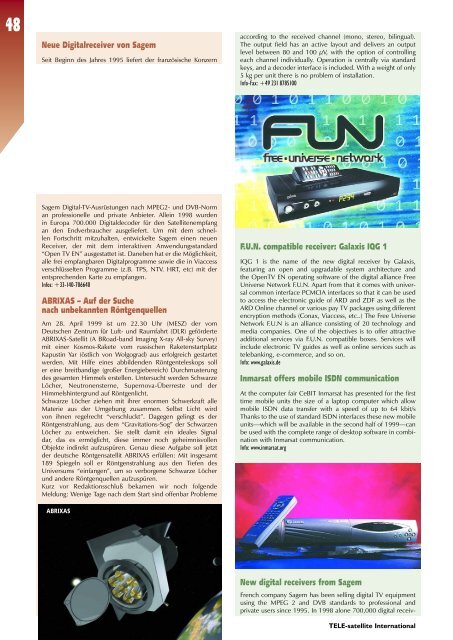TELE INTERNATIONAL - TELE-satellite International Magazine
TELE INTERNATIONAL - TELE-satellite International Magazine
TELE INTERNATIONAL - TELE-satellite International Magazine
You also want an ePaper? Increase the reach of your titles
YUMPU automatically turns print PDFs into web optimized ePapers that Google loves.
48<br />
Neue Digitalreceiver von Sagem<br />
Seit Beginn des Jahres 1995 liefert der französische Konzern<br />
Sagem Digital-TV-Ausrüstungen nach MPEG2- und DVB-Norm<br />
an professionelle und private Anbieter. Allein 1998 wurden<br />
in Europa 700.000 Digitaldecoder für den Satellitenempfang<br />
an den Endverbraucher ausgeliefert. Um mit dem schnellen<br />
Fortschritt mitzuhalten, entwickelte Sagem einen neuen<br />
Receiver, der mit dem interaktiven Anwendungsstandard<br />
“Open TV EN” ausgestattet ist. Daneben hat er die Möglichkeit,<br />
alle frei empfangbaren Digitalprogramme sowie die in Viaccess<br />
verschlüsselten Programme (z.B. TPS, NTV. HRT, etc) mit der<br />
entsprechenden Karte zu empfangen.<br />
Infos: +33-140-706640<br />
ABRIXAS – Auf der Suche<br />
nach unbekannten Röntgenquellen<br />
Am 28. April 1999 ist um 22.30 Uhr (MESZ) der vom<br />
Deutschen Zentrum für Luft- und Raumfahrt (DLR) geförderte<br />
ABRIXAS-Satellit (A BRoad-band Imaging X-ray All-sky Survey)<br />
mit einer Kosmos-Rakete vom russischen Raketenstartplatz<br />
Kapustin Yar (östlich von Wolgograd) aus erfolgreich gestartet<br />
werden. Mit Hilfe eines abbildenden Röntgenteleskops soll<br />
er eine breitbandige (großer Energiebereich) Durchmusterung<br />
des gesamten Himmels erstellen. Untersucht werden Schwarze<br />
Löcher, Neutronensterne, Supernova-Überreste und der<br />
Himmelshintergrund auf Röntgenlicht.<br />
Schwarze Löcher ziehen mit ihrer enormen Schwerkraft alle<br />
Materie aus der Umgebung zusammen. Selbst Licht wird<br />
von ihnen regelrecht “verschluckt”. Dagegen gelingt es der<br />
Röntgenstrahlung, aus dem “Gravitations-Sog” der Schwarzen<br />
Löcher zu entweichen. Sie stellt damit ein ideales Signal<br />
dar, das es ermöglicht, diese immer noch geheimnisvollen<br />
Objekte indirekt aufzuspüren. Genau diese Aufgabe soll jetzt<br />
der deutsche Röntgensatellit ABRIXAS erfüllen: Mit insgesamt<br />
189 Spiegeln soll er Röntgenstrahlung aus den Tiefen des<br />
Universums “einfangen”, um so verborgene Schwarze Löcher<br />
und andere Röntgenquellen aufzuspüren.<br />
Kurz vor Redaktionsschluß bekamen wir noch folgende<br />
Meldung: Wenige Tage nach dem Start sind offenbar Probleme<br />
ABRIXAS<br />
according to the received channel (mono, stereo, bilingual).<br />
The output field has an active layout and delivers an output<br />
level between 80 and 100 µV, with the option of controlling<br />
each channel individually. Operation is centrally via standard<br />
keys, and a decoder interface is included. With a weight of only<br />
5 kg per unit there is no problem of installation.<br />
Info-Fax: +49 231 8785100<br />
F.U.N. compatible receiver: Galaxis IQG 1<br />
IQG 1 is the name of the new digital receiver by Galaxis,<br />
featuring an open and upgradable system architecture and<br />
the OpenTV EN operating software of the digital alliance Free<br />
Universe Network F.U.N. Apart from that it comes with universal<br />
common interface PCMCIA interfaces so that it can be used<br />
to access the electronic guide of ARD and ZDF as well as the<br />
ARD Online channel or various pay TV packages using different<br />
encryption methods (Conax, Viaccess, etc..) The Free Universe<br />
Network F.U.N is an alliance consisting of 20 technology and<br />
media companies. One of the objectives is to offer attractive<br />
additional services via F.U.N. compatible boxes. Services will<br />
include electronic TV guides as well as online services such as<br />
telebanking, e-commerce, and so on.<br />
Info: www.galaxis.de<br />
Inmarsat offers mobile ISDN communication<br />
At the computer fair CeBIT Inmarsat has presented for the first<br />
time mobile units the size of a laptop computer which allow<br />
mobile ISDN data transfer with a speed of up to 64 kbit/s<br />
Thanks to the use of standard ISDN interfaces these new mobile<br />
units—which will be available in the second half of 1999—can<br />
be used with the complete range of desktop software in combination<br />
with Inmarsat communication.<br />
Info: www.inmarsat.org<br />
New digital receivers from Sagem<br />
French company Sagem has been selling digital TV equipment<br />
using the MPEG 2 and DVB standards to professional and<br />
private users since 1995. In 1998 alone 700,000 digital receiv-<br />
<strong>TELE</strong>-<strong>satellite</strong> <strong>International</strong>

















